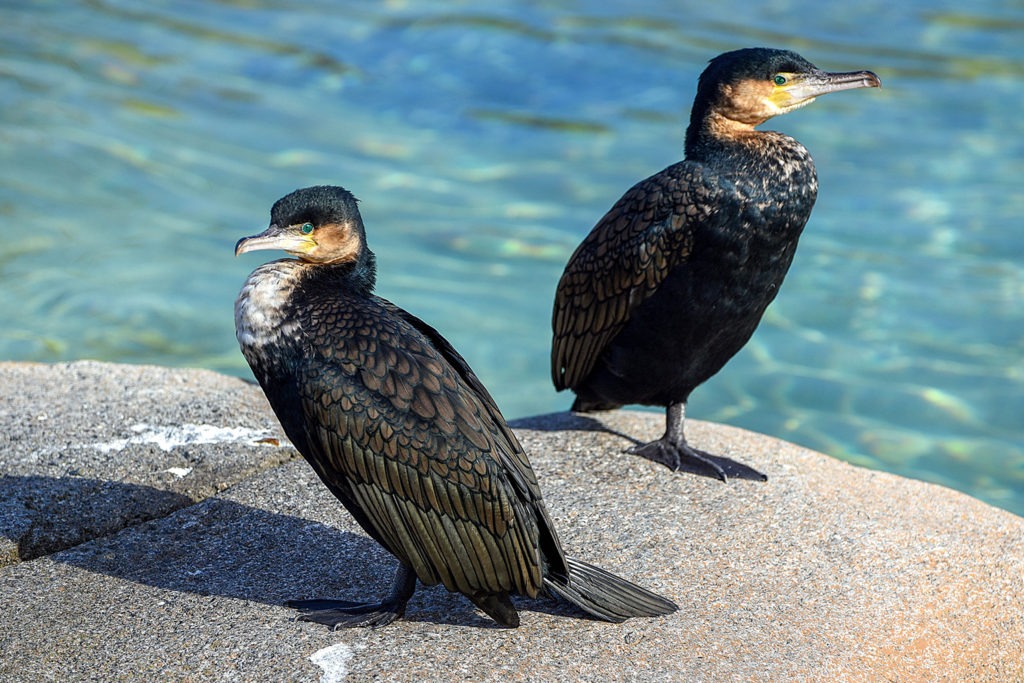Overview
“Where I live”
The white-breasted cormorant is an African sub-species of the great cormorant. White-breasted cormorants are found throughout sub-Saharan Africa, occurring in both coastal and inland water habitats, including estuaries, salt pans, deltas, mangrove swamps, coastal lagoons, coastal bays, rivers, and lakes. Head over to the Penguin Coast exhibit to see these birds at the Maryland Zoo.
“How I live there”
White-breasted cormorants are social birds that gather in colonies ranging from 20 to more than 200 birds. Active during the day, they dive for their supper. They will venture anywhere from 10 to 200 yards offshore (think 2 football fields) in search of fish. They dive to a depth of about 30 feet on average. While underwater, they grab fish in their beaks and swallow them immediately if small enough or else bring them back to shore to swallow. White-breasted cormorants also snap up amphibians, crustaceans, mollusks, and sometimes other bird nestlings.
“Making my mark”
As bird feathers go, those of the cormorant are unusual in that they allow moisture to penetrate. This makes cormorants heavier in water, allowing them to overcome some buoyancy and dive deeper. However, when these birds emerge from water, they must spend time preening and drying their feathers. This is why you’ll often see cormorants perched with wings outstretched.
“What threatens me”
Other than Cape Fur seals and feral dogs, there aren’t too many animals that try to eat adult white-breasted cormorants. However, cormorant chicks and eggs are much more vulnerable and may be taken by any number of predators, including Kelp gulls, Marabou stork, African fish-eagles, and yellow-billed kites.
Raising Young
White-breasted cormorants usually nest in mixed-species colonies and will often re-use sites and nests from previous years. On the coast, these birds tend to nest on islands, cliffs, or rocky shorelines. Males choose and defend nest sites and then try to attract females. They do so with a wing-waving motion, alternately showing and hiding the white patches on their thighs with outstretched wings. Once paired, a male and a female will reinforce their bond by gurgling, preening, and entwining their necks, among other behaviors.
Female white-breasted cormorants construct nests out of materials gathered by their mates. They lay clutches of 2 to 6 eggs and swap off with their mates incubating the eggs for roughly the next four weeks. Once the chicks hatch out, parents brood them continuously for about 2 weeks and continue to feed them for another 2 to 3 months. Cormorant chicks leave their nests after about 4 weeks and gather in crèches but parent birds continue to recognize and feed their own.
Conservation
White-breasted cormorant populations are stable throughout their range. These birds and the species to which they belong – the great cormorant – are listed as “least concern” by the IUCN, the world’s leading conservation organization. In other words, as a species they are not currently threatened.
Taxonomy
- Kingdom: Animalia
- Phylum: Chordata
- Subphylum: Vertebrata
- Class: Aves
- Order: Suliformes
- Family: Phalacrocoracidae
- Genera: Phalacrocorax
- Species: carbo lucidus


